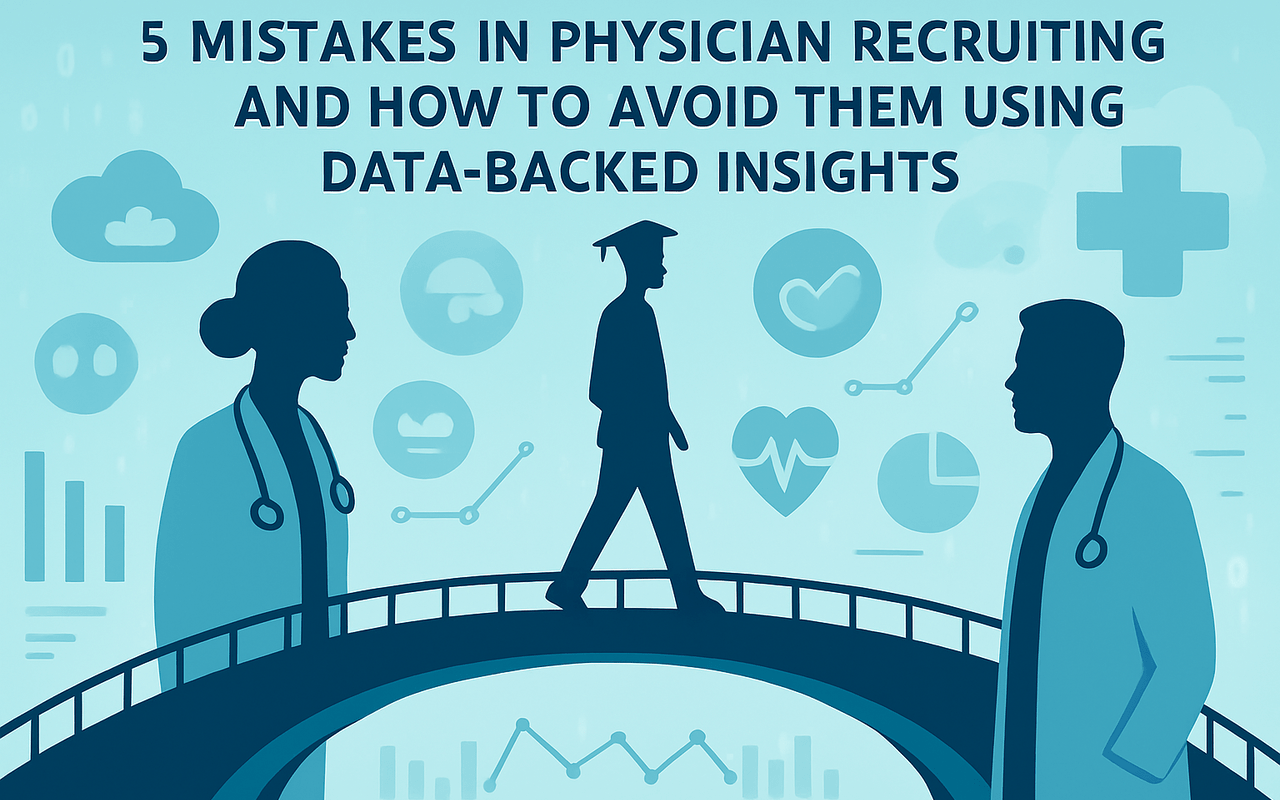5 Mistakes in Physician Recruiting (And How to Avoid Them Using Data-Backed Insights)

If you think an unfilled physician slot only hurts the HR statistics, look at the finance column instead. Industry data puts the loss from a single open physician post at US $7,000–9,000 per day, and the average vacancy stretches ≈ 195 days before a new hire clears credentialing.
That’s a $1.3 million hit per seat, before you factor in overtime, locum premiums, and the reputational damage of turning patients away. Worse still, the AAMC estimates the coming shortfall at up to 124,000 doctors by 2034. Supply is tightening just as your service lines need to expand.
When recruitment relies on instinct instead of data, future capacity and the balance sheet both often pay the price. The five mistakes below bleed margin in almost every hospital.
Fix them and you flip hiring from a reactive scramble to an evidence-driven, sub-90-day workflow that financial officers actually applaud.
5 Mistakes In Physician Recruiting That Still Bleed Margin
Legacy workflows, born in the fax era, continue to creep into 2025 search cycles. They look small on a Gantt chart but snowball into longer vacancy clocks, inflated locum spend, and, eventually, service-line caps.
Fixing them starts with the first, how you contact physicians in the first place, and ends with building a standing, data-driven pipeline.
Mistake #1: Spray-And-Pray Outreach Misses The Mark
Email remains the fastest way to get a job pitch in front of a physician, but only if the message actually lands. Industry-wide marketing benchmarks indicate an average open rate of 21.5% and a 2.3% click-through rate (CTR) for typical business emails.
Physician‐recruitment blasts, however, fare far worse. Another benchmarking of 3.2 million recruiter emails sent in 2024 found that untargeted campaigns rarely crack 10% opens and limp along at 2–3 % response.
Why The Gap?
Most recruiters still buy or recycle a “physician recruiters email list,” apply the same template to every address, and hope something sticks. The list almost never reflects current licensure status, recent procedure mix, or even whether the doctor is still practicing. Spam filters adapt quickly, once your domain earns a reputation for irrelevant mail, deliverability drops, and future roles, no matter how attractive, get buried in junk.
Worse, seasoned physicians share intel. One irrelevant pitch in a sub-specialty group chat can tag your brand as “spray-and-pray” for months.
The Data-First Fix
Start with clinical evidence, not a directory. In Alpha Sophia, you can combine five high-signal filters before writing a single sentence:
-
Actual Procedure Volume like hospitalists with >300 inpatient E/M CPT charges last year.
-
Payer Mix Alignment: Prospects whose Medicare–commercial split mirrors yours within ± 5 %.
-
Multi-State Licensure: Candidates already credentialed in the states you operate, no 90-day paperwork stall.
-
Network Centrality: Physicians in the top quartile of patient-sharing ties inside your referral grid.
-
Language & Community Tags: Match population-health goals (Spanish-speaking, rural practice experience, etc.).
Apply those filters, and a 5,000-name spreadsheet shrinks to perhaps forty clinicians who genuinely meet the criteria. Yet reply rates jump into the mid-20 percent range, nearly ten times the industry norm, because every recipient can see you did your homework.
Outreach volume plummets, but the signal soars, allowing recruiters to spend time on real conversations instead of chasing bounced emails.
With the right people now engaged, your next risk is assuming the résumés they send actually match what happens in the OR, an assumption that collapses fast when you compare paper claims with real billing data.
Mistake #2: Trusting CVs Over Claims Data Is A Costly Bet
A polished résumé can label someone a “high-volume interventional cardiologist.” Real-world billing often tells a different story.
A 2021 surgical-economics study found general surgeons over-reported operative times by a median of 26 minutes, directly inflating their RVUs.
More broadly, research comparing self-reported healthcare use to administrative records showed agreement plunging to just 30% for annual doctor-visit counts.
Translate those gaps into recruiting terms, and you get a familiar horror show that the “star” hire who can’t fill an OR block, the six-figure signing bonus tied up in remediation, and the vacancy clock restarting from zero.
Why The Gap?
Traditional vetting calendars the site visit first and verification second. By the time credentialing spots the volume mismatch, sunk costs such as flights, hotels, and the department chief’s time exert quiet pressure to compromise. The mis-hire goes through, productivity sags, and Finance wonders why procedural revenue missed the plan again.
The Data-First Fix
Flip the order. Verify first, shortlist later. Alpha Sophia ingests de-identified commercial and Medicare claims regularly, so recruiters can define competence in objective terms before the first phone call:
- >300 CPT 92928 stent placements in the last 12 months
- At least 60 complex PCI codes
- Active licenses in California and Nevada
- No disciplinary actions recorded by state boards
The platform returns a shortlist, each physician card backed by screenshot-ready wRVUs, DRG mix, and payer splits, which is evidence a hiring committee can parse in minutes.
Recruiters report that vetting sessions are shrinking from half-day panel interviews to 20-minute data huddles, and “paper-tiger” candidates never make it to the travel-expense stage. Moreover, time-to-fill drops, onboarding moves without last-minute surprises, and physicians land in roles that match their actual throughput.
Evidence-first vetting also boosts credibility with clinicians. When you open with, “We saw your 312 coronary interventions last year and think your skill set fits our Level-II cath lab,” you signal that this is not another volume-blind recruiter pitch. And that credibility is priceless when the conversation turns to licensure nuance and onboarding timelines, which is the focus of Mistake #3.
Every US physician at your fingertips. Always.

Mistake #3: Treating License & Compliance Checks as Late‑Stage Formalities
A glowing CV is worthless if the physician can’t legally practice on day one. State medical boards issued 6,469 disciplinary actions affecting 3,016 doctors in 2023 alone, a reminder that license status can change faster than your ATS updates.
Even when credentials are spotless, paperwork drags. AAPPR says traditional credentialing takes 30–60 days in streamlined states and up to 150 days elsewhere, every one of them another $7-9k in lost revenue.
Why The Gap?
Most teams still handle licence checks through manual board look-ups or outsourced verifications that kick in after an offer. By then, travel, interview, and committee hours are sunk, so uncovering a sanction or discovering the physician forgot to renew a DEA certificate forces an expensive “hold” or a hasty locum contract.
Telehealth expansion magnifies the pain because one missing cross-state license can sideline a clinician who otherwise fits your care model perfectly.
The Data-First Fix
Alpha Sophia surfaces publicly available license details like active, inactive, or pending, so recruiters can verify status early without manual board look‑ups.
Recruiters build “must-have” rules. For example, active CA + NV licenses, zero inactive flags, and the platform hides anyone who doesn’t clear that bar. Exported lists carry the license numbers and expiration dates, so credentialing teams can upload evidence instead of starting a new process.
The payoff is pure arithmetic. Two lost weeks at, say, $8,000 a day equals $112,000 in avoided leakage, per hire. Even better, surgeons and subspecialists notice you’ve done your homework.
Opening a call with, “We see your California and Nevada licenses run through 2027, perfect for our hub,” screams diligence.
With compliance gaps closed, the next revenue leak hides in plain sight, that is, sending the right message at the wrong time.
Mistake #4: Ignoring Engagement Intelligence In Outreach
Scroll through any recruiting CRM and you’ll see the same metric celebrated: “emails sent.” What you rarely see is whether those messages hit the inbox at the moment a physician is willing and able to respond.
Yet, a 17-million-message analysis of HIPAA-secure sends found that Saturday deliveries spike to 49% opens and 5% clicks, more than double the weekday averages. Add a personalized subject line, and open rates climb another 26%.
Why The Gap?
Many applicant-tracking tools stop tracking the conversation once an email leaves the outbox. Without open, click, and reply timestamps tied to each physician, recruiters default to 9 a.m. Tuesday blasts, precisely when an attending is hip-deep in rounds.
A second “just bumping this up” note, 48 hours later, only trains spam filters to block you faster.
The Data-Driven Fix
Alpha Sophia closes that blind spot. Its engagement graph feeds every open and click back to the individual NPI, so the next outreach triggers on real behaviour.
Within the platform, you can stack clinical filters like procedure volume, licensure, payer mix, and then add digital ones such as:
“Opened at least one weekend email in the past 90 days.”
“Clicked a compensation PDF during the last touch.”
With those signals, you schedule messages for the exact windows each doctor historically engages. For example, Saturday mornings for intensivists coming off night shifts, Thursday evenings for clinic-based pediatricians.
Six weeks of behavior-based timing is usually enough to lift reply rates from single digits, while overall send volume falls significantly. So fewer emails, better yield, and no burned sender reputation.
Moreover, this is followed by credibility. A cardiology fellow notices your note arrived at 6 a.m. Saturday, right when she reviews her inbox. It references her recent spike in left-main PCI volume. That level of precision says “we understand your workflow,” not “we scraped a list.” And that attention to detail sets the tone for the final hurdle, starting the search before the vacancy exists.
Mistake #5: Running A Reactive, Vacancy-Posted Pipeline
Most organizations open a requisition only after a resignation lands on the COO’s desk. The 2024 AAPPR benchmarking update indicates that it still takes approximately 129 days on average to fill a physician role, and specialty searches often exceed 135 days.
Layer on a 7.1% national physician turnover rate, and vacancies are a statistical certainty, not a surprise.
Why The Gap?
Pipeline work looks speculative on a quarterly budget. Leadership prefers recruiter hours aimed at live vacancies, so sourcing teams chase today’s emergency while tomorrow’s is already brewing.
By the time a role is formally posted, the best-fit physicians have fielded calls from faster competitors, and the hospital is stuck paying premium stop-gap rates.
The Data-Driven Fix
Alpha Sophia lets you keep potential matches “warmed up” instead of starting from zero. Some of the features are:
-
Build standing searches that combine clinical activity (e.g., “endocrinologists who billed > 800 outpatient encounters last year”), geography, and active state licences.
-
Save and export those lists to your CRM or email tool so nurture touches continue even when no req is open.
-
Refresh the data on a regular cadence. The platform’s claims and licence feeds update regularly, so a fellow who just received a second licence pops onto your radar without manual look-ups.
Recruiters who adopt this “rolling shortlist” approach have internal candidates queued before a resignation ever hits the COO’s inbox.
Instead of scrambling for résumés, they spend their first week confirming interest and scheduling site visits. Department chiefs move from “find anyone who can cover” to weighing two or three fully vetted options, and Finance sees vacancy leakage trending down instead of up.
No software erases the national physician shortage, but a saved search that updates itself is the closest thing to compound interest in recruiting. Every quarter you refresh and touch base, the warmer and cheaper your next hire becomes.
By shifting effort from reactive back-fill to continuous pipeline care, you protect revenue, spare clinical teams the locum merry-go-round, and keep executive conversations focused on growth rather than crisis containment.
Find any and every HCP, not just the ones looking for a job

FAQs
What are the most common mistakes in physician recruiting today?
The patterns show up again and again in data. Like blasting the same email to every doctor in a zip code, trusting a résumé without checking real procedure volume, waiting until the offer stage to verify licenses, sending outreach at the wrong time of day, and only starting a search once a physician resigns. Fix those five habits, and the entire hiring timeline shrinks.
How does data improve the targeting process in physician recruitment?
When you can slice the market by CPT® volume, state license, location, and practice setting, your list shrinks from thousands of “maybe” names to a few dozen high-probability fits. Smaller list, bigger response.
What types of filters help narrow down high-potential candidates?
The most useful combinations are procedure-volume thresholds, multi-state license status, specialty taxonomy, payer mix tags, and geography. Alpha Sophia exposes each of those fields, allowing you to build compound rules in one pass.
Can I use Alpha Sophia to identify residents and early-career physicians?
Yes. Because the claims and license feeds refresh regularly, newly licensed or recently graduated clinicians appear as soon as their first procedures or new state licenses are added to the databases.
How does historical engagement data improve future recruiting outcomes?
A healthcare-wide analysis shows that Saturday sends hit 49% opens and 5% clicks, which is double the weekday levels, and segmented lists more than double the click-throughs again. Saving those interaction metrics allows recruiters to time follow-ups when each physician typically responds.
What role does licensure and compliance data play in hiring success?
State boards issued 1,196 serious sanctions against physicians in 2023. Screening licence status and expiration before an offer prevents last-minute stalls that can cost $8 $8k a day in lost revenue.
How can data help align hiring with long-term hospital growth plans?
Saved searches that refresh quarterly keep a living pool of pre-qualified talent for high-demand specialties. When a vacancy opens, recruiters start with warm names instead of a blank screen, cutting weeks off search time.
What’s the ROI of using a data-intelligence platform for physician hiring?
Every day, shaving off the 129-day median time-to-fill is roughly an $ 8,000 swing back to the black. Even a modest 10% reduction recoups about $100 k per hire.
Conclusion
Physician recruiting will never be “easy” with a national shortfall looming, but it should be predictable. Public benchmarks lay the problem bare. 129-day searches, 7% turnover, and $7–9k in revenue lost every 24 hours a chair sits empty.
The fixes are not silver bullets, but they involve disciplined workflows, such as micro-segmented outreach, claims-verified vetting, license checks upfront, engagement timed to real physician behavior, and evergreen talent pools that refresh with every new claims update.
Alpha Sophia simply makes it easier to execute at scale by giving recruiters the same level of data precision clinicians expect in the OR. Swap guesswork for evidence, and the vacancy meter finally slows, along with the revenue bleed that keeps finance up at night.
